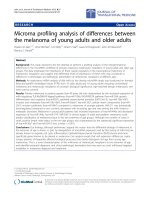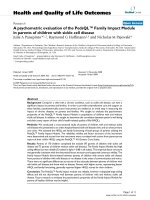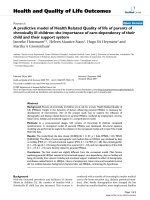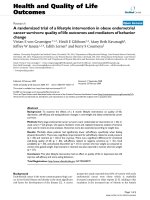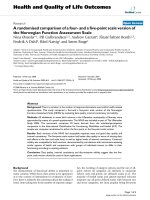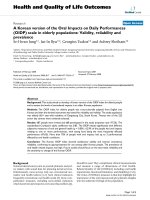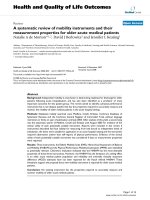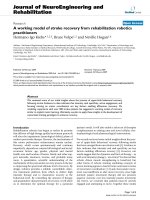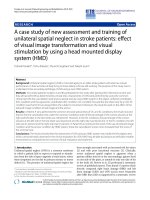báo cáo hóa học:" A retrospective analysis of clinicopathological and prognostic characteristics of ovarian tumors in the State of Espírito Santo, Brazil" ppt
Bạn đang xem bản rút gọn của tài liệu. Xem và tải ngay bản đầy đủ của tài liệu tại đây (1.11 MB, 10 trang )
RESEARCH Open Access
A retrospective analysis of clinicopathological and
prognostic characteristics of ovarian tumors in
the State of Espírito Santo, Brazil
Marcela F Paes
1
, Renata D Daltoé
1,2
, Klesia P Madeira
1
, Lucas CD Rezende
1
, Gabriela M Sirtoli
1
, Alice L Herlinger
1
,
Leticia S Souza
3
, Luciana B Coitinho
2
, Débora Silva
1
, Murilo F Cerri
1
, Ana Cristina N Chiaradia
1
, Alex A Carvalho
4
,
Ian V Silva
3
and Leticia BA Rangel
1*
Abstract
Background: Ovarian cancer is sixth most common cancer among women and the leading cause of death in
women with gynecological malignancies. Despite the great impact ovarian cancer has on women’s health and its
great impact in public economy, Brazil still lacks valuable information concerning epidemiological aspects of this
disease
Methods: We’ve compiled clinical data of all ovarian tumors registered at the two public hospitals of reference
(1997 - 2007), such as: patients’ age at diagnosis, tumor histological type, tumor stage, chemotherapy regimens,
chemotherapy responsiveness, disease-fre e survival, and overall survival.
Results: Women’s mean age at diagnosis was 54.67 ± 13.84 for ovarian cancer, 46.15 ± 11.15 for borderline
tumors, and 42.01 ± 15.06 for adenomas. Among epithelial ovarian cancer cases, 30.1% were of serous, 13.7% were
of mucinous, and 13.7% were of endometrioid type; exceptionally serous carcinoma was diagnosed in women
younger than 30 years old. Endometrioid cancer had lower disease-free survival than others (p < 0.05). Cases were
predominantly diagnosed as poor prognosis disease (FIGO III and IV, 56.2%). Regarding responsiveness to platinum-
based therapy, 17.1% of patients were resistant, whereas 24.6%, susceptible. From these, we found equally
responsiveness to platinum alone or its association with paclitaxel or cyclophosphamide.
Discussion: Our data agreed with other studies regarding mean patients’ age at diagnosis, histological type
frequency, FIGO stages distribution, and chemotherapy regimens. However, the histological type distribution, with
equal contribution of mucinous and endometrioid types seems to be a unique characteristic of the studied highly
miscegenated population.
Conclusion: We have enlighten the profile of the studied ovarian cancer population, which might enable the
development of more efficient political strategies to control this malignancy that is the fifth leading cause of
cancer-related deaths among women.
Keywords: ovarian neoplasias, Espírito Santo, retrospective study, clinical outcome, gynecological disease
* Correspondence:
1
Laboratório de Biologia Celular e Molecular do Câncer Humano,
Departamento de Ciências Farmacêuticas, 2° Andar, Sala 08, Centro de
Ciências da Saúde, Universidade Federal do Espírito Santo, Maruípe, Vitória,
ES - Brazil. CEP: 29043-900
Full list of author information is available at the end of the article
Paes et al. Journal of Ovarian Research 2011, 4:14
/>© 2011 Paes et al; licensee BioMed Central Ltd. This is an Open Access article distributed under the terms o f the Creative Commons
Attribution License ( which permits unre stricted use, distribution, and repro duction in
any medium, provided the original work is properly cited.
Background
Ovarian tumors can be classified as primary peritoneal
carcinoma, Fallopian tube cancer, germinative tumors,
benign epithelial ovarian tumors (adenomas), tumors of
low malignant potential (borderline tumors), or malig-
nant epithelial tumors (adenocarcinomas); being the lat-
est the focus of the present article. Whereas most
epithelial ovarian tumors are benign, do not spread, and
usually do not lead to serious illness [1], epithelial ovar-
ian cancer (EOC) is the ninth most common cancer
among women, excluding non-melanoma skin cancers,
ranking fifth in cancer-related deaths [1]. Indeed, accord-
ing to the American Cancer Society, EOC accounts for
more deaths than any other cancer of the female repro-
duc tive system [1]. In the U.S.A., 21.990 new EOC case s,
and 15.460 EOC-related deaths are expected in 2011 [1].
The epidemiological scenario of EOC derives, at least
partially, from inefficient diagnosis/prognosis strategies
mainly due to the lack of specific symptoms at the initial
stages of EOC. As a consequence, about 70% EOC are
diagnosed at advanced stages when the usually metastatic
tumor has acquired drug resistant phenotype [2].
World public health systems are dramatically affected
by the inexistence of specific and sensitive EOC biomar-
kers; therefore compromising the early detection of the
disease when patients’ survival rates would be as high as
85% [3]. Nonetheless, the two screening tests available
for the detection of sporadic EOC - transvaginal sonogra-
phyandserumCA-125dosage-havebeenproven
unspecific so that their diagnostic relevance remains con-
troversial. Regarding EOC therapeutics, the standard pro-
cedure includes cytoreduction followed by platinum-
based adjuvant chemotherapy. Unfortunately, many
patients will experience disease recurrence and will ulti-
mately die from EOC [4].
It has been documented that the higher incidence of
EOC is among women at their 60’s or older [1]. As the
world’ s population ages, remarkable increases in the
total number of EOC cases are expected [5], emphasiz-
ing the importance of EOC in public health matters.
The Brazilian National Institute of Cancer (INCA)
describes EOC as a high mortality gynecological malig-
nancy [6]. In spit e of the impact of EOC statistics in
public economy, Brazil still lacks precise epidemiologic
data on the disease, which would support the develop-
ment of sustainable and more efficient political stra te-
gies to control the malignancy.
In conclusion, Brazil urges for epidemiologi cal studies
on EOC to characterize and understand the disease pro-
file in specific populations. Herein, we present a pioneer
epidemiologic study of ovarian tumors aiming to charac-
terize the disease in Espírito Santo, a Brazilian State
with highly miscegenated population, as will be further
discussed, regarding the characteristics associated with
EOC, such as: patients’ age at diagnosis, ovarian neopla-
sia pathologic profile (histological classification, tumor
staging, and tumor degree of differentiation), responsive-
ness to chemotherapy, and patients’ clinical outcome
and survival rate.
Methods
Data source
A retrospective study conducted with primary ovarian
neoplasia (benign or malignant) cases registered in the
two reference public hospitals in cancer diagnosis and
treatment in the state of Espírito Santo (Brazil): Hospital
Universitário Cassiano Antônio de Morais (HUCAM)
and Hospital Santa Rita de Cássia (HSRC). Clinical
included: patients’ age at diagnosis, tumor histological
type, tumor FIGO stage, tumor degree of differentiation,
chemotherapy regimens, chemotherapy responsiveness
or re sistance, disease recurrence and disease-free period,
and patients’ survival. EOC classification has been col-
lected from patients’ clinical reports, and has been per-
formed by the Pathology Departments from the referred
hospitals, following high laboratorial quality control sys-
tems. The present work has been conducted in observa-
tion with human righ ts recommendations , following
UFES’s Institutional Review Board approval (protocol #
042/07; approval date 01/08/2007); all patients involved
have signed the Term of Free and Informed Consent
and their clinical follow up information were kept in
confidential records.
Geographic characteristics of the State of Espírito Santo,
Brazil
The present data have been collected at the Brazilian
State of Espírtito Santo, located in the Southeastern Bra-
zil, which capital is Vitória (-20° 19’ 10’’ S, 40° 20’ 16’’
W), comprising a total area of 46,077,519 km
2
.Accord-
ing to Brazilian Institute of Geography and Statistics [7]
(Instituto Brasileiro de Geografia e Estatística, IBGE,
from Portuguese), the estimated population of the State
in 2009 has been 3,487,199 people.
Cohort definition
Thepresentstudyincludedallovarianadenomas,bor-
derli ne tumors, and cancers registered at HUCAM from
1997 to 2007 and at HSRC from 2001 to 2007. Despite
this extensive s ampling, the main focus of the present
study was the epidemiological characterization of pri-
mary ovarian malignant epithelial tumors. With this
regard, we have excluded all cases of non-primary ovar-
ian tumor and non-epithelial EOC from the analysis.
Statistical Analysis
Data are expressed as absolute values and percentage or
as mean ± standard deviation (SD). Statistically relevant
Paes et al. Journal of Ovarian Research 2011, 4:14
/>Page 2 of 10
differences among age at diagnosis were accessed using
Students’ T-Test or one-way analysis of variance
(ANOVA), followed by Turkey post-test to perform
individual comparisons. E OC FIGO stage distribution
varying by tumor histological type has been compared
using chi-square test. For further analysis, we have
grouped tumor cl assified as FIGO stages I and II as a
better prognosis disease group, whereas tum ors desig-
nated as FIGO stages III and IV as a poor prognosis dis-
ease group, and, once again, analyzed its distribution
among histological types using chi-square test.
To better understand and characterize our studied
population, Kaplan-Meier curves have been plotted
using patients’ death or disease relapse as endpoints
(considered overall survival and disease-free survival,
respectively). The curves have been generated for each
of the mainly observed histological types (endometrio id,
mucinous, and serous ), patients’ age at diagnosis sepa-
rated in groups (less than 40 years old, 41 to 60 years
old, and 61 or more years old), EOC FIGO stage (I, II,
III, and IV), and adjuvant chemotherapy regime n (plati-
num only, platinum associated with paclitaxel, and plati-
num associated with cyclophosphamide). Curves have
been compared using the Mantel-Cox Log-Rank test. It
is important to notice that on ly patients who underwent
one single type of adjuvant therapy have been included
in this analysis. Data are expressed as p-value of Log-
Rank analysis, harzard ratio (HR), and 95% Confidence
Interval (IC95%). All statistical analyses have been per-
formed using GraphPad Prism 5.0 software.
Results and Discussion
Results
Inthepresent,wehaveanalyzed248primaryovarian
epithelial neoplasias: 83 adenomas, 19 borderline tumors
and 146 cancers, registered in the t wo main cancer ser-
vices of the state of Espírito Santo, Brazil, as described
in the Methods section. The population characterization
revealed that the mean age of women at ovarian neopla-
sia diagnosis was 49.86 ± 15.22. Interestingly, there was
significant statistic difference of women’s age at diagno-
sis according to the type of ovarian epithelial neoplasia
(adenoma, borderline tumor, and cancer) (one way
ANOVA p < 0.0001). For EOC, the mean patients’ age
at diagnosis was 54.67 ± 13.84, which was significantly
different from that of borderline tumo rs (46.15 ± 11.15;
Turkey post-test, p < 0.05), and adenomas (42.01 ±
15.06; Turkey post-test, p < 0.0001). No significant dif-
ference has been noted between wo men’s age at diagno-
sis for adenomas and borderline tumors (Table 1). As
for FIGO staging, the mean age at diagnosis was 47.97 ±
11.54 for stage I, 51.60 ± 12.50 for stage II, 56.89 ±
14.44 for stage III and 60.27 ± 11.16 for stage IV, show-
ing a possible positive corr elation between patients’ age
at diagnosis and tumor FIGO staging (data not shown).
As stated in the Methods section, EOC graded as stages
I and II are related to better prognosis disease, whereas
stages III e IV correspond to poorest prognosis EOC.
We have observed a statically relevant difference
between the patients’ age at diagnosis between the
group of better prognosis (48.90 ± 11.74) and the group
of poorest prognosis disease (57.90 ± 13.52; T-Test p =
0.0014; data not shown).
Pathologic profile of EOC included in this study is pre-
sented in Table 2. As expected, we have observed a
higher prevalence of ovarian serous adenocarcinoma (n =
44) when compared to ovarian mucinous adenocarci-
noma (n = 20), ovarian endometrioid adenocarcinoma
(n = 20), and ovarian clear cell adenocarcinoma (n = 3).
Considering the most prevalent primary EOC histological
types (serous, mucinous, and endometrioid), there was no
statistical significant diffe rences at women’sageatdiag-
nosis. However, it is worthwhile to point that the only
histological type that affected women under the age of 30
year old was serous carcinoma, while for other EOC his-
tological types every case was diagnosed after this age,
Table 1 Characterization of the ovarian tumor cases registered (diagnosed and/or treated) at the collaborator
hospitals
Parameters EOC and stages Borderline Adenoma
Total I II III IV
N 146 29 10 35 15 19 83
Age at diagnosis
(mean ± SD)
54.67 ± 13.84* 47.96 ± 11.54 51.6 ± 12.5 58.9 ±
14.4
60.3 ± 11.2 46.15 ±
11.15
42.01 ± 15.06
30 or less 8 (5.5%) 3 (10.3%) 1 (10,0%) 2 (5.7%) 0 (0.0%) 2 (10.5%) 21 (25.3%)
31 to 40 11 (7.5%) 3 (10.3%) 1 (10,0%) 1 (2.9%) 0 (0.0%) 4 (21.1%) 19 (22.9%)
41 to 50 42 (28.8%) 12 (31.4%) 2 (20,0%) 13 (37.1%) 4 (2.7%) 7 (36.8%) 13 (15.7%)
51 to 60 32 (21.9%) 5 (17.2%) 4 (40,0%) 3 (8.6%) 4 (2.7%) 3 (15.8%) 15 (18.0%)
Over 60 52 (35.6%) 4 (13.8%) 2 (20,0%) 16 (45.7%) 7 (46.7%) 3 (15.8%) 12 (14.5%)
Missing data 1 (0.7%) 0 (0.0%) 0 (0,0%) 0 (0.0%) 0 (0.0%) 0 (0.0%) 3 (3.6%)
* One-way ANOVA: p < 0.05 when compared to borderline and p < 0.001 when compared to adenoma
Paes et al. Journal of Ovarian Research 2011, 4:14
/>Page 3 of 10
and this tendency is statistically significant (Fisher’stest,
p = 0.0126; data not shown) (Table 3).
Regarding EOC FIGO classification, we have docu-
mented 29 cases diagnosed at stage I, 10 cases detected
at stage II, 35 cases diagnosed at stage III, and 15 cases
detected at stage IV, in a total of 89 staged cancers. We
have also observed a slight predominance of poor staged
cancers, as 43.8% of cases had a better prognosis profile
(I a nd II) versus 56.2% of the cases that showed a poor
prognosis standard (III and IV). Analyzing the FIGO
staging of the tumor within each histological type cate-
gory, we could not establish any statistically relevant
association. Interestingly, 58.3% of the ovarian endome-
trioid adenocarcinomas, for which data was available,
were FIGO-classified as stage I tumors, whereas for
serous and mucinous o varian adenocarcinomas the
referred proportions were 34.4% and 33.3%, respec tivel y
(Table 3). Among EOC with available degree of differen-
tiation data, we have noticed a prevalence of moderatel y
differentiated tumors, while poorly differentiated and
highly differentiated ones were observed almost at the
same range (Table 2). As for laterality of the tumors,
only 35.6% of the analyzed clinical charts documented
this disease characteristic, and bilateral EOCs were
slightly more frequent than unilateral ones (Table 2).
Patient s’ clinical outcome and chemotherapy regimens
prescribed to EOC patients have been also analyzed, and
the correspondent data are compiled in Tables 4 and 5.
Considering patients for which data was available only,
Table 2 Pathologic profile of epithelial ovarian cancers
Parameters N (%)
Histological Type
Serous 44(30.1)
Mucinous 20(13.7)
Endometrioid 20(13.7)
Clear cells 3(2.1)
Adenocarcinoma without other specification 58(39.7)
Others 1(0.7)
FIGO Stage
I 29(19.9)
II 10(6.9)
III 35(23.9)
IV 15(10.3)
Missing data 57(39.0)
Differentiation Grade
Well 18(12.3)
Moderate 30(20.6)
Poor 17(11.6)
Missing data 81(55.5)
Laterality
Left 11(7.5)
Right 12(8.2)
Bilateral 29(19.9)
Missing data 94(64.4)
Table 3 Characteristics of the most observed cancer
histological types
Parameters Histological Type Totalª
Endometrioid Serous Mucinous
Age at
diagnosis
(mean ± SD)
54.80 ± 12.76 52.70 ±
15.95
51.76 ±
8.85
52.72 ±
13.71
30 or less 0(0.0%) 7(15.9%) 0(0.0%) 7(8.4%)
31 to 40 2(10.0%) 3(6.8%) 1(5.0%) 6(7.1%)
41 to 50 8(40.0%) 10(22.7%) 11(55.0%) 29(34.5%)
51 to 60 2(10.0%) 9(20.5%) 3(15.0%) 14(16.7%)
More than
60
8(40.0%) 15(34.1%) 5(25.0%) 28(33.3%)
FIGO Stage
I 7(35.0%) 11(25.0%) 5(25.0%) 23(27.4%)
II 2(10.0%) 6(13.6%) 1(5.0%) 9(10.7%)
III 1(5.0%) 13(29.6%) 7(35.0%) 21(25.0%)
IV 2(10.0%) 2(4.5%) 2(10.0%) 6(7.1%)
Missing
data
8(40.0%) 12(27.3%) 5(25.0%) 25(29.8%)
ªTotal cases of EOC specified as endometrioid, serous or mucinous.
Table 4 Treatment and clinical outcome of the ovarian
cancer patients
Parameter N (%)
Neoadjuvant Therapy
Yes 10(6.9)
No 91(62.3)
Missing data 45(30.8)
Adjuvant Therapy
Yes 68(46.6)
No 16(11.0)
Deceased before therapy 3(2.0)
Missing or insufficient data 59(40.4)
Post-Relapse Therapy
Yes 23(74.2)
No 2(6.3)
Missing or insufficient data 6(19.5)
Clinical Outcome
Cure 7(4.8)
Disease-free 23(15.7)
Relapse 30(20.5)
Death before relapse 24(16.4)
Relapse after cure 1(0.7)
Missing or insufficient data 61(41.8)
Platinum responsiveness
Resistant 25(17.1)
Susceptible 33(22.6)
No platinum-based therapy 17(11.6)
Missing or insufficient data 71(48.6)
Paes et al. Journal of Ovarian Research 2011, 4:14
/>Page 4 of 10
we have observed that 10% of the patients underwent
neoadjuvant therapy, 78% of them received adjuvant
therapy and, from those whose disease has relapsed,
92% got post-relapse therapy. Concerning the che-
motherapy regimens prescribed to EOC patients, we
have noted: i) for neoadjuvant therapy: 90% of the
patients r eceived a platinum-based regimen, being 70%
of them in association with paclitaxel; ii) for adjuvant
therapy: about 82.4% of the patients got the first choice
adjuvant therapy with platinum-based drug, being 47.1%
treated with platinum associated with paclitaxel, 20.6%
platinum associated w ith cyclophosphamide, and 14.7%
platinum alone; iii) for post-relapse therapy: 56.4% of
the patients received platinum-based therapy. As for pla-
tinum-based therapy responsiveness, 17.1% of the
patients were resistant to the treatment, whereas 22.6%
were susceptible to this therapy (Table 4).
Finally, EOC patients’ overallsurvival(OS)profilehas
been investigated in regard to the disease histological
type, FIGO staging, adjuvant therapy, and patients’ age
at diagnosis (Figure 1). For this analysis, we have consid-
ered the most prevalent EOC histological types (serous,
endometrioid, and mucinous) of the studied population,
and the most common prescribed adjuvant therapies
(platinum only, platinum associated with paclitaxel, or
platinum associated with cyclophosphamide). We have
not been able to correlate histological type or adjuvant
therapy with patients’ OS (Log-Rank p > 0.05). On the
other hand, and co nfiguring crucial information regar d-
ing the epidemiological profile of E OC, women’sOS
was statistically associated with the patients’ age at diag-
nosis (Log-Rank p = 0.029) and the tumor FIGO staging
(Log-Rank p = 0.004). In deed, performing every possibl e
pair of comparisons, we have observed that patients
diagnosed with E OC after the age of 60 years old had
described a poor OS when compared to the group of
patients diagnosed before the age of 40 years old (Log-
Rank p = 0.0179), and also when compared to the group
of patients diagnosed between 41 and 60 years old (p =
0.057). Although the Kaplan-Meier curve shows a differ-
ent trend of OS regarding patients diagnosed before 20
years old and patients diagnosed between 41 and 60
years old, no statistically significant association has been
observed (Log-Rank p = 0.169). The same type of analy-
sis was performed with FIGO data : patients carrying
EOC FIGO-staged IV showed a poor OS when com-
pared to those classified as stage I tumors (Log-Rank p
= 0.0003), stage II (Log-Rank p = 0.025), and stage III
(p = 0.055). Additionally, the OS difference between
patients diagnosed wit h EOC FIGO-stag ed I or III wa s
also statistically relevant (Log-Rank p = 0.033). The
other pairs of comp arisons have not shown any statisti-
cally different survival trend (Figure 1).
Kaplan-Meier curves have been also generated using
EOC relapse as the endpoint, in order to analyze the dis-
ease-free survival (DFS) in regard to the tumor histologi-
cal type, tumor FIGO staging, patients’ age a t diagnosis,
and adjuvant therapy regimen prescribed to the EOC
patient. We had observed a statistically relevant different
DFS when comparing FIGO stages (Log-Rank, p =
0.035), but only limitrophe statistical relevance when
compared tumor histological types (Log-Rank, p = 0.056)
and the patients’ age at diagnosis (Log-Rank, p = 0.0529).
No statistically relevance could be noted when adjuvant
treatments were compared (Log-Rank, p = 0.126). Com-
paringeverypossiblepairofcurves,wehadcometo
some interesting findings. As for tumor histological type,
the DFS in endometrioid cancers was lower than in ser-
ous (Log-Rank, p = 0.048) and in mucinous (Log-Rank p
= 0.016) EOC. Regarding tumor FIGO staging, the only
statistically relevant decrease in DFS has been observed
between the tumors at stages I and IV (Log-Rank, p =
0.0054). Patients diagnosed with EOC at the age of 40
years old or less have shown a higher DFS comparing to
patients whose diagnosis has occurred between the ages
of 41 and 60 yea rs old, and also to patients whose cancer
has been detected at an age older than 60 years old (Log-
Rank, p = 0.026 and p = 0.021, respectively). Although no
overall statistically relevant difference has been observed
for the type of adjuvant treatment received by EOC
patients, the ones treated only with platinum have show n
Table 5 Chemotherapy regimens prescribed to the
ovarian cancer patients
Chemotherapy N (%)
Neoadjuvant
Platinum 1(10.0)
Platinum + Paclitaxel 7(70.0)
Platinum + Cyclophosphamide 1(10.0)
No information 1(10.0)
Adjuvant
Platinum 10(14.7)
Paclitaxel 3(4.4)
Cyclophosphamide 1(1.4)
Platinum + Paclitaxel 32(47.1)
Platinum + Cyclophosphamide 14(20.6)
Doxorubicin 1(1.5)
No information 7(10.3)
Post-Relapse
Platinum 4(17.3)
Paclitaxel 2(8.7)
Gemcitabine 5(21.7)
Topotecam 1(4.4)
Etoposide 1(4.4)
Platinum + Paclitaxel 9(39.1)
No information 1(4.4)
Chemoterapies most commonly applied
Paes et al. Journal of Ovarian Research 2011, 4:14
/>Page 5 of 10
a lower DFS than those treated with the association of
platinum and c iclophosphamide (Log-Rank, p = 0.042).
Every other comparison has not resulted in statistically
relevant results, even though the curves may show some
interesting trends (Figure 2).
Discussion
As the world population ages, governmental health policy
might consider the social, economic, and psychological
impacts of age-related diseases, as cancer, on individuals
quality of life. In developing countri es, as Brazil, the
referred increased lifespan of the population is a mile-
stone event in determining efficient and sustainable stra-
tegies regarding public health matters. Moreover, it ha s
been recently reported that Brazilian women are
expected to live longer than men, supporting the urge in
establishing gender-specific health guidelines [8]. In this
context, it is of fundamental importance to conduct epi-
demiological studies on femal e issues, as EOC, to under-
stand and characterize not excl usively the disease profile
in specific populations, but also to enable the proposition
of more effici ent diagnosis and therapeutic approaches.
Even though EOC incidence is considerably lower than
that of other cancers, as breast cancer, the lack of disease
pathogno monic symptoms, specific biomarkers, and effi-
cient diagnosis tests result in its detection at metastatic
and late stages when the disease prognosis is poor.
Therefore, regardless its ninth position in incidence, it is
the fifth leading cause of cancer-related deaths among
women [1,9]. Besides the emotional impact in carriers’
life, cancer management is associated to high economic
cost both to public and private health care systems,
including expendures with chemotherapy, health care,
side effects control, and lost or decreased ability to work
[10]. On the other hand, as estimated by a Brazilian
health insurance c ompany, treatment of late-diagnosed
cancer can cost eight times more money than the control
of early-staged malignancy [6].
The World Health Organization has estimated 224,747
new cases of EOC in the world population in 2 008.
From these, approximately 43% would be diagnosed in
women older than 60 years old [11]. North-American
statistics have pointed that women are usually diagnosed
with EOC after menopause. Indeed, approximately 50%
Figure 1 Kaplan-Meier Overall survival curves. A: Overall survival comparison among histological types. Endometrioid vs. Mucinous (Log-Rank
p = 0.562; HR = 1.31; CI95% = 0.48-3.82); Endometrioid vs. Serous (Log-Rank p = 0.152; HR = 2.12; CI95% = 0.76-5.89); Serous vs. Mucinous (Log-
Rank p = 0.421; HR = 1.53; CI95% = 0.54-4.35). B: Overall survival comparison among FIGO stages. I vs. II (Log-Rank p = 0.452; HR = 2.16; CI95% =
0.29-16.28); I vs. III (Log-Rank p = 0.033; HR = 3.07; CI95% = 1.09-8.61); I vs. IV (Log-Rank p = 0.0003; HR = 12.56 CI95% = 3.19-49.46); II vs. III (Log-
Rank p = 0.458; HR = 1.63; CI95% = 0.45-5.95); II vs. IV (Log-Rank p = 0.025; HR = 4.40; CI95% = 1.20-16.13); III vs. IV (Log-Rank p = 0.055; HR =
2.87; CI95% = 0.97-8.45). C: Overall survival comparison among groups of age at diagnosis. 40 years old or less vs. 41 to 60 years old (Log-Rank
p = 0.170; HR = 2.04; CI95% = 0.73-5.64); 40 years old or less vs. above 60 years old (Log-Rank p = 0.018; HR = 2.91; CI95% = 1.20-7.04); 41 to 60
years old vs. above 60 years old (Log-Rank p = 0.057; HR = 1.817; CI95% = 0.98-3.36). D: Overall survival comparison among adjuvant treatment
regimens. Platinum only vs. Platinum-Paclitaxel (Log-Rank p = 0.347; HR = 2.02; CI95% = 0.46-8.80); Platinum only vs. Platinum-Ciclophosphamide
(Log-Rank p = 0.499; HR = 1.89; CI95% = 0.30-1.99); Platinum-Paclitaxel vs. Platinum-Ciclophosphamide (Log-Rank p = 0.633; HR = 1.31; CI95% =
0.43-4.00).
Paes et al. Journal of Ovarian Research 2011, 4:14
/>Page 6 of 10
of EOC c ases registered in the USA are diagnosed in
women at the age of 60 years old or later [1]. In the
present study, we have observed that the mean patients’
age at EOC diagnosis was 54.67 ± 13.84, which is in
consonance with national and international publications
[12-17]. Similarly to what is observed in breast cancer,
estrogen and hormone therapy ( HT) seems to play an
important role in EOC [18]. An i ncreased EOC inci-
dence after combined estrogen plus progestin therapy
was s uggested by a randomized, double-blind, placebo-
controlled trial including 16,608 postmeno pausal
women [19]. Yet, when we consider the dualistic classifi-
cation of EOC (further discussed in this section), estro-
gen shows distinct roles. In type I EOC, it acts as a
continued growth stimulus to promote cell proliferation;
whereas, in type II EOC, it acts on an initiating event
rather than as a growth factor [20]. On the other hand,
women are usually diagn osed with o varian borderline
tumors at younger ages. In a study conducted in Singa-
pore,Wongetal[21]havereportedthatthemean
women’s age at ovarian borderline tumors diagnosis was
38 years old, ranging from 16-89 years old. Another
study developed in France have documented that one
third of ovarian borderline tumors are diagnosed in
women younger than 40 years old, and more than 80%
of cases are detected early in an disease course [22].
Moreover, these tumors tend to affect women at a
younger age than the typical EOCs in the USA [1]. Cor-
respondingly, our data have shown that the average age
of patients diagnosed with b orderline tumors (46.15 ±
11.15) was significantly lower (p <0.05) than the age at
diagnosis of EOC cases (54.67 ± 13.84). The tendency to
correlate more aggressive tumors diagnosed at late ages
is corroborat ed by the results showing that ovarian ade-
nomas are also diagnosed earlier than EOC [9]. The
mean age at ovarian adenoma diagnosis in our studied
population was 42.01 ± 15.06, significantly lower (p
<0.001) than that observed for EOC detection (54.67 ±
13.84). Therefore, our data substantiate the statement
that the malignant transformation of normal cells is an
aging-related phenomenon. More specifically, EOC is, in
fact, a disease of the aged women.
As reported by other groups, serous carcinoma is
the most common histological type of EOC [23-26].
Figure 2 Kaplan-Meier Disease-free survival curves. A: Disease-free survival comparison among histological types. Endometrioid vs. Mucinous
(Log-Rank p = 0.016; HR = 5.18; CI95% = 1.36-19.74); Endometrioid vs. Serous (Log-Rank p = 0.048; HR = 3.29; CI95% = 1.01-10.70); Serous vs.
Mucinous (Log-Rank p = 0.072; HR = 1.19; CI96% = 0.37-3.82). B: Disease-free survival comparison among FIGO stages. I vs. II (Log-Rank p = 0.071;
HR = 1.31; CI95% = 0.38-7.87); I vs. III (Log-Rank p = 0.109; HR = 2.38; CI95% = 0.82-6.88); I vs. IV (Log-Rank p = 0.005; HR = 17.09; CI95% = 2.31-
126.07); II vs. III (Log-Rank p = 0.408; HR = 1.73; CI95% = 0.47-6.37); II vs. IV (Log-Rank p = 0.136; HR = 3.66; CI95% = 0.66-20.18); III vs. IV (Log-
Rank p = 0.157; HR = 3.64; CI95% = 0.75-17.75). C: Disease-free survival comparison among groups of age at diagnosis. 40 years old or less vs. 41
to 60 years old (Log-Rank p = 0.026; HR = 3.75; CI95% = 1.17-11.91); 40 years old or less × above 60 years old (Log-Rank p = 0.021; HR = 4.72;
CI95% = 1.26-17.72); 41 to 60 years old × above 60 years old (Log-Rank p = 0.406; HR = 1.42; CI95% = 0.62-3.28). D: Disease-free survival
comparison among adjuvant treatment regimens. Platinum only × Platinum-Paclitaxel (Log-Rank p = 0.488; HR = 1.72; CI95% = 0.37-7.95);
Platinum only × Platinum-Ciclophosphamide (Log-Rank p = 0.042; HR = 8.95; CI95% = 1.08-73.95); Platinum-Paclitaxel × Platinum-
Ciclophosphamide (Log-Rank p = 0.121; HR = 2.65; CI95% = 0.77-9.05).
Paes et al. Journal of Ovarian Research 2011, 4:14
/>Page 7 of 10
In agreement, our group has identified 44 ovarian serous
adenocarcinomas, corresponding to 30.1% of the ana-
lyzed cases. Furthermore, some groups found ovarian
mucinous adenocarcinoma as the second most frequent
diagnosed EOC [17,26], including other studies con-
ducted in Brazil [16,17,27], whereas others have pointed
to ovarian endometrioid adeno carcinoma occupying the
second position in EOC incidence rank [24,25]. In con-
trast, our analysis has indicated equal proportions of
both ovarian mucinous and endometrioid adenocarci-
noma within the EOC cases evaluated (13.7%). Intrigu-
ingly, all cases of EOC diagnosed in women younger
than age 30 years old were of serous type. Though
remarkable, this observation is novel, at least to our
knowledge, and has not been described in other epide-
miological correlated studies. Even though the referred
Brazilian EOC studies did not aim to analyze the epide-
miology of the disease, therefore might not be consid-
ered an absolute distribution of EOC cases in the
populations studied, the lack of correlated data in the
literature lead us to compare our results to the frac-
tioned population described in the cited articles. One
interesting aspect is that all the Brazilian studies men-
tioned above were performed in São Paulo State,
although in distinct cities, in a way that, altogether, they
might enlighten EOC profile in the State as a whole. It
has been described that São Paulo State has a distinct
population composition when compared to Espírito
Santo State. According to IBGE data from 2008 [28],
the populations from São Paulo and Espírito Santo
States are composed by, respectively: 67.2% and 42.2%
Caucasian; 6.2% and 8.5% Afrodescendant; 25.4% and
48.6% Brown (Pardo) and 1.3% and 0.7% Native Brazi-
lians. These data indicate the higher population misce-
genation observed in Espírito Santo State, which is
explained mainly by several immigration cycles that
have began in the 14
th
Century with the Brazilian colo-
nization by Portugal. During the following years, the
Espírito Sant o State has also received immigrant s from
Africa, Italy, Spain and Germany, as well as from other
regions from Brazil [29]. Finally, as published in 2008 by
IBGE [28], the State of Espírito Santo has a higher per-
centage of miscegenated population (Afrodescendant,
Caucasian and Native Brazilians) when compared to
the overall Brazilian population (50.6% and 42.6%,
respectively).
Most of the EOC c ases analyzed herein were FIGO-
staged as I or III tumors (19.9% and 23.9%, respectively),
in agreement with data published by Kim et al [30], who
have reported an incidence of 39% of EOC detected in
stage I, and 42.7% of EOC diagnosed in stage III in a
study performed in Chicago, USA. In another study con-
ducted in USA, the authors have observed the same dis-
ease pattern [31]. The EOC FIGO-staging profile has
also been documented in other studies performed in
Brazil: Badiglian Filho et al [27] have reported an inci-
dence of 26.3% and 42%, and Derchain et al [32] of 34%
and 51%, of EOC staged I and III, respectively. Interest-
ingly, our data have shown a slightly higher predomi-
nance of poor prognosis EOC (stages III and IV), which
accounted for 56.2% of the cases, while 43.8% of the
tumors were in the group of better prognosis disease
(stages I and II), when only the cases containing infor-
mation are considered. Our data is in accordance with
other studies conducted in the USA, Indonesia, and
Brazil [26,27,32,33].
Expanding our EOC epidemiological analysis to the
patients’ OS profile, our group has not observed signifi-
cant differences in death risk among EOC histological
types. Nevertheless, ovarian endometrioid adenocarcino-
mas have a lower DFS than any other EOC histological
types. In contrast, others have pointed to the ovarian
mucinous adenocarcinomas as the poorest prognosis
EOC, which have a lower progression-free survival when
compared to ovarian endometrioid and serous adenocar-
cinomas [14,34]. Although we cannot explain the differ-
ences between our observations and that of other
authors, one might speculate that lower DFS identified
within the ovarian endometrioid adenocarcinomas group
could be due to the higher patients’ age at EOC diagno-
sis for this histological type in the studied population.
EOC therapeutic management is based on the combina-
tion of a platinum-derived compound (carboplatin, mainly,
or cisplatin), and a taxane (paclitaxel). As documented by
Aebi and Castiglione [35], the referred drug combination
seems to confer a better response rate than the platinum-
derived compound alone, therefore increasing EOC car-
riers’ survival rate. In agreement with worldwide EOC
therapeutic guidelines, the association of platinum-derived
drug and paclitaxel was the first choice chemotherapy
regimen prescribed to the investigated EOC patients in
both neoadjuvant and adjuvant schemes. The cited drug
association has been given to 70% and 47.1% of EOC
cases, respectively, followed by platinum combined to
cyclophosphamide (10% and 20.6%, respectively), or only
platinum (10% and 14.7%, respectively). Contrasting to the
observations of Aebi and Castiglione [35], we have not
identified significant differences in the patients’ OS rate or
in the DFS in the group of women who have received pla-
tinum and paclitaxel compared to those treated with plati-
num alone or platinum combined to cyclophosphamide.
This finding is intriguing as it provides evidences that the
control of EOC might be conducted in an efficient but yet
less toxic therapeutic regimen, as apart from the classic
antineoplasic drugs side effects, paclitaxel is neurotoxic
and cyclophosphamide can lead to the development of
hemorrhagic cystitis. It is important to emphasize that we
are not neglecting the importance of drug combination to
Paes et al. Journal of Ovarian Research 2011, 4:14
/>Page 8 of 10
control EOC; however, it might be interesting to revisit the
standard clinical protocols in a way to increase the disease
treatment success in the cases of platinum-resistant EOC,
which can account to as much as 80% of all treated EOC
in Brazil (unpublished data).
Considering the lack of EOC epidemiology information
in Brazil, we strongly b elieve to have provided substan-
tiated data on the matter. Indeed, results presented herein
have enlightened the EOC epidemiology in Espírito Santo
State, and due to the State miscegenated population could,
in some extent, give broader hints of the disease profile.
On the other hand, we have faced some difficulties during
the elaboration of this manuscript that might not be
neglected. First, despite the highly qualified medical staff
involved in the disease diagnosis and patient care, as well
as the strict methods and high quality procedures followed
by them, we have noticed an insufficient data recording at
the patient’s medical reports. Second, patients’ follow-up
has not always be en adequate, being shorter tha n the
ideal, and, once more, there has been lack of some infor-
mation during this period. Finally, new insights related to
the development of EOC should be considered during
tumor diagnosis and pathologic classification, such as the
possible origin of high grade ovarian carcinomas from fal-
lopian tubes and the dualistic model of EOC classification.
Classically, the origin of EOC has been referred as from
mesothelial cells in which metaplasic changes would lead
to different EOC’s histological types. However, more
recently, it has been proposed that the majority of what
seemed to be primary EOC are derived from other organs,
such as the Fallopian tubes [36,37].Inthiscontext,Shi
and Kurman [38] proposed a dualistic model that cate-
gorizes the types of EOC into two groups, designated type
I and type II. According to this model, type I comprises
tumors confined to the ovary that develops from well
established precursors, the borderline tumors; whereas
type II is composed of tumors that are aggressive, present
in advanced stage, and develops from intraepithelial carci-
nomas in the fallopian tube. Despite the evidences that
EOC classification methods should be revisited, it is of
remarkable importance to emphasize that EOC analysis in
the Brazilian Public Health Systems, and in most of the
private hospitals as well, remains based on the FIGO clas-
sification system.
Conclusions
We herein present a pioneer detailed epidemiological
study on EOC, considering the dis ease pathology aspects,
the chemotherapy regimens prescribed to carrier women,
and the patients’ survival profile. We have corroborated
to the statement that the malignant transformation of
ovarian normal cells is an aging-related phenomenon,
affecting mostly menopausal women. Moreover, EOC
cases registered in the highly miscegenated population of
the state of Espírito Santo, Brazil, are: i) mainly of the
serous histological type followed equally by the mucinous
and endometrioid types; ii) of the serous type in all cases
diagnosed in w omen younger than age 30 years old; iii)
with lower DFS if classified as endometrioid adenocarci-
noma; iv) mostly diagnosed as poor prognosis disease,
although still at a lower prevalence than in other Brazi-
lian states; v) equally responsive to the association of pla-
tinum and paclitaxel, of platinum and cyclophospham ide
or to plat inum alone, therefore suggesting that the con-
trol of EOC might be conducted in an efficient but yet
less toxic therapeutic regimen, and p ointing to the need
to revisit the standard clinical protocols in a way to
increase the disease treatment success in the cases of pla-
tinum-resistant E OC. In conclusion, we have character-
ized the clinicopathological and prognostic aspects of the
studied EOC population. We strongly suggest that our
data might guide the development of sustainable and
more efficient political strategies to improve the control
of this malignancy that is the fifth leading cause of can-
cer-related deaths among woman.
List of Abbreviations
ACS: (American Cancer Society); ANOVA: (Analysis of variance); CA-125:
(Cancer Antigen 125); CI95%: (95% Confidence Interval); DFS: (Disease-free
survival); EOC: (Epithelial Ovarian Cancer); FIGO: (International Federation of
Gynecology and Obstetrics); HR: (Hazard Ratio); HSRC: (Santa Rita de Cássia
Hospital); HUCAM: (Cassiano Antônio de Moraes University Hospital) ; INCA:
(Brazilian National Institute of Cancer); OS: (Overall survival); SD: (Standard
deviation).
Acknowledgements
The authors thank CAPES, FACITEC and CNPq for financial support, and the
Hospitals HUCAM and HSRC for allowing data collection.
Author details
1
Laboratório de Biologia Celular e Molecular do Câncer Humano,
Departamento de Ciências Farmacêuticas, 2° Andar, Sala 08, Centro de
Ciências da Saúde, Universidade Federal do Espírito Santo, Maruípe, Vitória,
ES - Brazil. CEP: 29043-900.
2
Centro de Ciências Agrárias, Universidade
Federal do Espírito Santo, Alto Universitário, s/n° - Cx Postal 16, Guararema,
Alegre, ES -Brazil. CEP: 29500-000.
3
Laboratório de Biologia Celular do
Envelhecimento, Departmaneto de Morfologia, 1° Andar, Sala 05, Centro de
Ciências da Saúde, Universidade Federal do Espírito Santo, Maruípe, Vitória,
ES - Brazil.
4
Departamento de Patologia, Hospital Cassiano Antônio de
Moraes (HUCAM), Avenida Marechal Campos, s/n°, Maruípe, Vitória, ES -
Brazil. CEP: 29040-191.
Authors’ contributions
MFP: clinical data collection, manuscript writing, manuscript revision and
corrections; RDD, KPM, LCDR, GMS, ALH, LSS, LBCDS, MFC, ACNC: clinical
data collection and manuscript writing; AAC: Clinical data collection ; IVS:
Clinical data collection and paper writing supervision; LBAR: Intellectual
mentorship, clinical data collection and paper writing supervision. All authors
have read and approved the final manuscript.
Competing interests
The authors declare that they have no competing interests.
Received: 13 June 2011 Accepted: 9 August 2011
Published: 9 August 2011
Paes et al. Journal of Ovarian Research 2011, 4:14
/>Page 9 of 10
References
1. American Cancer Society. Cancer Facts and Figures 2011. [http://www.
cancer.org/Cancer/OvarianCancer/DetailedGuide/ovarian-cancer-key-
statistics], Accessed in August 5, 2011.
2. Jacobs IJ, Menon U: Progress and challenges in screening for early
detection of ovarian cancer. Mol Cell Proteomics 2004, 3:355-66.
3. Tchabo NE, Liel MS, Kohin EC: Applying proteomics in clinical trials:
Assessing the potential and practical limitation in ovarian cancer. Am J
Pharmacogenomics 2005, 5:141-8.
4. Willmott LJ, Fruehauf JP: Targeted therapy in ovarian cancer. J Oncol 2010,
9, Article ID 740472.
5. Janssen-Heijnen ML, Houterman S, Lemmens VE, Louwman MW, Maas HA,
Coebergh JW: Prognostic impact of increasingage and co-morbity in
cancer patients: A population-base approach. Crit Rev Oncol Hematol
2005, 55:231-40.
6. Instituto Nacional de Câncer (INCA): Coordenação Nacional de Controle
do Tabagismo, Prevenção e Vigilância de Câncer. Registros Hospitalares de
Câncer: Rotinas e Procedimentos. 1 edition. Rio de Janeiro: Ministério da
Saúde - Secretaria Nacional de Assistência à Saúde; 2000, 7.
7. Instituto Brasileiro de Geografia e Estatística (IBGE). Estados: Espírito
Santo. [ />8. Rede Interagencial de Informações para a Saúde (RIPSA). Indicadores e
dados básicos - Brasil 2008. [], Accessed in
August 5, 2011.
9. Lee KR, Tavassoli FA, Prat J, Dietel M, Gersell DJ, Karseladze AI,
Hauptmann S, Rutgers J, Russel P, Buckley CH, Pisani P, Shwartz P,
Goldgar DE, Silva E, Caduff R, Kubik-Huch RA: Tumours of the ovary and
peritoneum. Pathology and genetics: Tumours of the breast and female
genital organs. 4 edition. Lyon: IARC Press; 2003, 113-114.
10. Bodurka-Bevers D, Sun CC, Gershenson DM: Pharmacoeconomic
considerations in treating ovarian cancer. Pharmacoeconomics 2000,
17:133-50.
11. World Health Organization. Globocan 2008 - Cancer Incidence and
Mortality Worldwide in 2008. [ />12. Lima GR, Girão MJBC, Carvalho FM: Ovário. Diagnóstico, classificação,
estadiamento e terapêutica cirúrgica. In Ginecologia Oncológica 1 edition.
Edited by: Atheneu. São Paulo: Lima GR, Gebrim LH, Oliveira VC, Martins NV;
1999:358-360.
13. Skírnisdóttir I, Garmo H, Wilander E, Holmberg L: Borderline ovarian
tumors in Sweden 1960-2005: trends in incidence and age at diagnosis
compared to ovarian cancer. Int J Cancer 2008, 123:1897-901.
14. Winter WE, Maxwell GL, Tian C, Carlson JW, Ozols RF, Rose PG, et al:
Prognostic Factors for Stage III Epithelial Ovarian Cancer:A Gynecologic
Oncology Group Study. J Clin Oncol 2010, 25:3621-7.
15. Koh SC, Razvi K, Chan YH, Narasimhan K, Ilancheran A, Low JJ, Choolani M:
The Ovarian Cancer Research Consortium of SE Asia. The association
with age, human tissue kallikreins 6 and 10 and hemostatic markers for
survival outcome from epithelial ovarian cancer. Arch Gynecol Obstet
2011, 284(1):183-190.
16. Chan JK, Tian C, Monk BJ, Herzog T, Kapp DS, Bell J: Prognostic factors for
high-risk early-stage epithelial ovarian cancer: a Gynecologic Oncology
Group study. Cancer
2008, 15:2202-10.
17. Luiz BM, Miranda PF, Maia EMC, Machado RB, Giatti MJL, Antico Filho A,
Borges JBR: Epidemiological Study of Ovary Tumor Patients in the city of
Jundiaí from June, 2001 to June, 2006. RBC 2009, 55:247-53.
18. Cunat S, Hoffmann P, Pujol P: Estrogens and epithelial ovarian cancer.
Gynecologic Oncology 2004, 94:25-32.
19. Anderson GL, Judd HL, Kaunitz AM, Barad DH, Beresford SA, Pettinger M,
Liu J, McNeeley SG, Lopez AM: Effects of estrogen plus progestin on
gynecologic cancers and associated diagnostic procedures: the
Women’s Health Initiative randomized trial. JAMA 2003, 290(13):1739-48.
20. Hecht JL, Kotsopoulos J, Hankinson SE, Tworoger SS: Relationship between
epidemiologic risk factors and hormone receptor expression in ovarian
cancer: results from the Nurses’ Health Study. Cancer Epidemiol Biomarkers
Prev 2009, 18(5):1624-30.
21. Wong HF, Low JJ, Chua Y, Busmanis I, Tay EH, Ho TH: Ovarian tumors of
borderline malignancy: a review of 247 patients from 1991 to 2004. Int J
Gynecol Cancer 2007, 17:342-9.
22. Poncelet C, Fauvet R, Yazbeck C, Coutant C, Darai E: Impact of serum
tumor marker determination on the management of women with
borderline ovarian tumors: Multivariate analysis of a French multicentre
study. Eur J Surg Oncol 2010, 36(11):1066-72.
23. Ioka A, Tsukuma H, Ajiki W, Oshima A: Ovarian cancer incidence and
survival by histologic type in Osaka, Japan. Cancer Sci 2003, 94:292-6.
24. Rangel LB, Agarwal R, Sherman-Baust CA, Mello-Coelho V, Pizer ES, Ji H,
et al: Anomalous Expression of the HLA-DR α and β Chains in Ovarian
and Other Cancer. Cancer Biol Ther 2004, 3:1021-7.
25. Inai K, Shimizu Y, Kawai K, Tokunaga M, Soda M, Mabuchi K, et al: A
Pathology Study of Malignant and Benign Ovarian Tumors Among
Atomic-Bomb Survivors - Case Series Report. J Radiat Res 2006, 47:49-59.
26. Lurie G, Wilkens LR, Thompson PJ, Matsuno RK, Carney ME, Goodman MT:
Symptom presentation in invasive ovarian carcinoma by tumor
histological type and grade in a multiethnic population: A case analysis.
Gynecol Oncol 2010, 119(2):278-84.
27. Badiglian Filho L, Oshima CT, De Oliveira Lima F, De Oliveira Costa H, De
Sousa Damião R, Gomes TS, Gonçalves WJ: Canonical and noncanonical
Wnt pathway: a comparison among normal ovary, benign ovarian tumor
and ovarian cancer. Oncol Rep 2009, 21:313-20.
28. Instituto Brasileiro de Geografia e Estatística. Indicadores Sociais:Síntese
de Indicadores Sociais 2008. [ />populacao/condicaodevida/indicadoresminimos/sinteseindicsociais2008/
default.shtm], Accessed in August 5, 2011.
29. Saletto N: Sobre a composição étnica da população capixaba. Associação
Nacional de História - Seção Espírito Santo. [ />planet/anpuhes/ensaio25.htm].
30. Kim S, Dolecek TA, Davis FG: Racial differences in stage at diagnosis and
survival from epithelial ovarian cancer: A fundamental cause of disease
approach. Soc Sci Med 2010, 71:274-81.
31. Ali-Fehmi R, Semaan A, Sethi S, Arabi H, Bandyopadhyay S, Hussein YR:
Molecular Typing of Epithelial Ovarian Carcinomas Using Inflammatory
Markers. Cancer 2011, 117(2):301-9.
32. Derchain SFM, Torres JC, Teixeira LC, Andrade LALA, Masuko FKM,
Santos MA: Relaçäo entre tumores ovarianos epiteliais borderline e
francamente invasores: epidemiologia, histologia e prognóstico. Rev bras
ginecol obstet 1999, 21(5):273-277.
33. Aziz MF: Gynecological cancer in Indonesia. J Gynecol Oncol 2009, 20:8-10.
34. Wimberger P, Wehling M, Lehmann N, Kimmig R, Schmalfeldt B, Burges A,
Harter P, Pfisterer J, du Bois A: Influence of residual tumor on outcome in
ovarian cancer patients with FIGO stage IV disease: an exploratory
analysis of the AGO-OVAR (Arbeitsgemeinschaft Gynaekologische
Onkologie Ovarian Cancer Study Group). Ann Surg Oncol 2010, 17:1642-8.
35. Aebi S, Castiglione M: Epithelial ovarian carcinoma: ESMO clinical
recommendations for diagnosis, treatment and follow-up. Annals of
Oncology 2008, 19:ii14-6.
36. Dubeau L: The cell of origin of ovarian epithelial tumours. Lancet Oncol
2008, 9(12):1191-7.
37. Kurman RJ, Shih IeM: The origin and pathogenesis of epithelial ovarian
cancer: a proposed unifying theory. Am J Surg Pathol 2010, 34(3):433-43.
38. Shih IeM, Kurman RJ: Ovarian tumorigenesis: a proposed model based on
morphological and molecular genetic analysis. Am J Pathol 2004,
164(5):1511-8.
doi:10.1186/1757-2215-4-14
Cite this article as: Paes et al.: A retrospective analysis of
clinicopathological and prognostic characteristics of ovarian tumors in
the State of Espírito Santo, Brazil. Journal of Ovarian Research 2011 4:14.
Paes et al. Journal of Ovarian Research 2011, 4:14
/>Page 10 of 10

